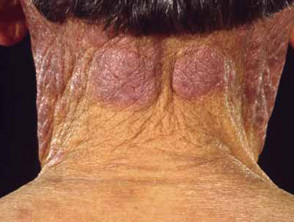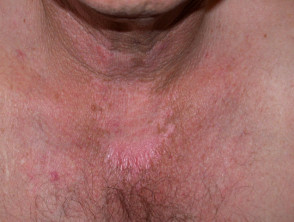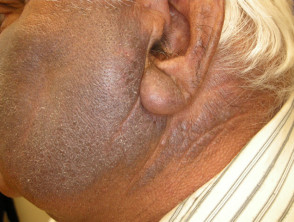What is photosensitivity?
Photosensitivity refers to various symptoms, diseases and conditions caused or aggravated by exposure to sunlight.
- A rash due to photosensitivity is a photodermatosis (plural photodermatoses).
- If the rash is eczematous, it is a photodermatitis.
- A chemical or drug that causes photosensitivity is a photosensitiser.
- A phototoxic reaction to a photosensitiser results in an exaggerated sunburn reaction and no immune reaction is involved.
- A photoallergic reaction to a photosensitiser results in photodermatitis and is due to delayed hypersensitivity reaction.
- A photoexacerbated condition describes a flare of an underlying skin disease on exposure to sunlight.
Photosensitive rashes
Who gets photosensitivity?
Photosensitivity occurs in males and females of all races and at all ages. Different types of photosensitivity may be prevalent at different times of life. Genetic and environmental factors are involved.
People with very white skin who don’t tan on exposure to the sun (Fitzpatrick skin type 1), especially if they also have red hair and blue eyes, are often considered photosensitive, relative to people with darker skin phototypes who tan more easily. These fair skinned individuals do not have a photodermatosis.
Classification of photosensitivity
Photosensitivity is classified into the following groups:
Primary photodermatoses
The causes of primary or idiopathic photodermatoses have not yet been discovered. Exposure to the sun produces a clearly defined disease entity. These include:
- Polymorphic light eruption
- Juvenile spring eruption
- Actinic folliculitis
- Actinic prurigo
- Solar urticaria
- Chronic actinic/photosensitivity dermatitis
- Hydroa vacciniforme (associated with Epstein-Barr virus).
With the exception of polymorphic light eruption and juvenile spring eruption, these disorders are rare.
Exogenous photodermatoses
Exogenous photodermatoses are those in which phototoxic or photoallergic reaction is caused by an external photosensitiser. These include:
- Drug-induced photosensitivity: common photosensitising drugs are thiazides, tetracyclines, non-steroidal anti-inflammatory drugs (NSAIDs), phenothiazines, voriconazole, quinine, vemurafenib
- Photocontact dermatitis: due to phototoxic chemicals such as psoralens in plants, vegetables, fruit, fragrances in cosmetics, sunscreen chemicals, dyes, and disinfectants
- Pseudoporphyria: induced by drugs and/or renal insufficiency.
Photoexacerbated dermatoses
Photoexacerbated dermatoses include:
- Lupus erythematosus
- Dermatomyositis
- Darier disease
- Rosacea
- Pemphigus vulgaris
- Pemphigus foliaceus
- Atopic dermatitis
- Psoriasis.
Metabolic photodermatoses
Photosensitivity can be caused by a metabolic defect. The most common disorders of this type are porphyrias, in which phototoxic porphyrins accumulate in the skin. There are genetic defects in various enzymes, and the diseases may be activated by exposure to certain medications or toxins. Clinical presentation depends on which enzyme is defective.
- Porphyria cutanea tarda
- Erythropoeitic protoporphyria
- Variegate porphyria
- Erythropoeitic porphyria (Gunther disease)
Pellagra, due to vitamin B3 (niacin) deficiency usually presents initially with photosensitivity. It may be primary due to inadequate dietary intake, genetic (Hartnup disease), or secondary such as drug-induced or malabsorption.
Genetic photodermatoses
Photosensitivity can be associated with a pre-existing genetic disorder. These are rare.
- Xeroderma pigmentosum
- Bloom syndrome
- Rothmund-Thomson syndrome
- Cockayne syndrome
- Hartnup disease (see Pellagra)
What causes photosensitivity?
Photosensitivity is caused by an abnormal reaction to some component of the electromagnetic spectrum of sunlight and a chromophore (reactive compound) within the skin.
The electromagnetic spectrum ranges from cosmic rays, invisible rays called ultraviolet radiation (UVR), through visible light, to infrared, microwaves and radio waves. UVR has 3 portions.
- UVC: ultrashort wavelength rays 200–290 nm that do not reach the earth’s surface
- UVB: short-wavelength rays 290–320 nm that cause sunburn and tan
- UVA: longer wavelength rays 320–400 nm that cause tanning and also suppress immune reactions in the skin
Patients can be sensitive to one kind of sunlight (i.e. only to UVB, UVA or visible light) or to a wider range of radiation. The most common photosensitivity is to UVA. Properties of UVA include:
- Present throughout the year, but there is more UVA during summer
- Present throughout the day, but there is more UVA around the solar noon that earlier or later
- UVA is of lower energy than UVB, thus photon for photon, UVA is less damaging than UVB to DNA in skin cells
- UVA is however 100 times more prevalent at the earth’s surface than UVB
- UVA can penetrate through the epidermis into the dermis thus UVA damages more deeply than UVB
- UVA can penetrate untreated and untinted glass, which blocks UVB
- UVA is blocked by polycarbonate and densely woven fabric
Porphyria is mainly triggered by exposure to visible light.
What are the clinical features of photosensitivity?
The clinical features depend on the specific photodermatosis.
- Photodermatoses affect areas exposed to sunlight (face, neck, hands) and do not affect areas not exposed to the light (covered at least by underwear), or are less severe in covered areas.
- Sometimes they spare areas that are habitually exposed to the light, eg the face in polymorphic light eruption.
- Sometimes they only affect certain parts of the body, eg juvenile spring eruption is confined to the tops of the ears.
- Photodermatoses may also occur following indoor exposure to artificial sources of UVR (eg fluorescent lamps) or visible radiation.
Rashes on exposed sites may be due to another cause. For example:
- Facial acne due to follicular occlusion by sebum and keratin
- Contact dermatitis due to makeup applied to the face
- Airborne contact dermatitis due to plant pollens, such as sesquiterpene lactone.
Clues to photosensitivity include:
- Summer exacerbation; note that many photodermatoses are present year-round
- The sharp cut-off between affected area and skin covered by clothing or jewellery (eg, watch strap, ring)
- Sparing of folds of upper eyelids
- Sparing of deep furrows on face and neck
- Sparing of skin covered by hair
- Sparing of skin shadowed by the ears, under the nose and under the chin
- Sparing of the web spaces between the fingers
Complications of photosensitivity
Severe photosensitivity can lead to a person being unable to go outdoors during the day unless completely covered (including face). This leads to social isolation and depression.
Some photodermatoses cause permanent scarring.
How is photosensitivity diagnosed?
Photosensitivity is diagnosed by the history of a skin problem arising on exposure to sunlight. The specific type is determined by examination of the skin and specific tests.
Photosensitivity is sometimes confirmed by phototests — artificial light from various different sources and at different doses is shone on small areas of the skin to see whether the rash can be reproduced, or if sunburn occurs more easily than expected. These tests can be difficult to perform and to interpret and are only available in specialised centres.
Contact photosensitivity can be tested by photopatch tests, in association with standard patch tests. Adhesive patches containing known photosensitising materials are applied to the upper back, removed after two days, and light is shone on the area. The reaction is observed two days later.
Investigations may include:
- Full blood count
- Connective tissue antibodies including antinuclear antibodies (ANA), extractable nuclear antigens (ENA)
- Porphyrins in blood, urine and faeces
Patients suspected of porphyria cutanea tarda may also have liver function tests and iron tests.
What is the treatment for photosensitivity?
Management of photosensitivity involves sun protection and treatment of the underlying disorder.
How can photosensitivity reactions be prevented?
Photosensitivity reactions are mainly prevented by careful protection from sun exposure and avoidance of exposure to artificial sources of UVR. However:
- The degree of protection needed from UVR depends on the severity of the disorder and the geographic location of the patient.
- Protection from UVR using sunscreens alone is not effective for porphyria. Affected areas must be covered when outdoors.
- Graduated exposure to small amounts of UVR may reduce sun-induced reactions in polymorphous light eruption.
Protection from UVR
When considering sun-protective measures:
- Take note of the time of year and time of day. UVR is greater when the sun is overhead.
- Find out local ultraviolet levels. In New Zealand, Sun Alert reports from NIWA's National Climate Database indicate the hours when the UV index (UVI) is over 3 and therefore significant.
- Download a smartphone app reporting local UVI levels.
- Note that the temperature and to some extent weather conditions make little difference to environmental UV.
- Be aware of greater UVR at altitude, and when reflected by bright surfaces, like snow, concrete and sand.
- Do not rely on shade from tree, umbrella or sail. UVR is scattered by dust particles, meaning may they may provide only partial protection.
- Watch out for a small amount of UVR released from some unguarded fluorescent daylight lamps.
Sunscreens are essential.
- Sunscreens often fail to completely prevent photodermatoses.
- Sunscreens are best at filtering out UVB. To be most effective, they need to be applied thickly and frequently to all exposed skin.
- Select a sunscreen with a very high Sun Protection Factor (SPF 50+), which is a water-resistant and broad-spectrum product that complies with current Australian and New Zealand Standard for Sunscreens (AS/NZS2604:2012), or the equivalent in other countries.
- Sunscreens containing reflectants such as zinc may be more effective than pure chemical sunscreens, as they filter out more UVA. They can be messy to use and cosmetically unappealing.
- Contact allergic dermatitis to sunscreens or contact photodermatitis to sunscreen chemicals can occur uncommonly, particularly to benzophenone or butyl methoxy dibenzoyl methane, and in the past, to para-aminobenzoic acid (PABA).
Patients with photodermatoses also may need to:
- Take vitamin D supplements
- Confine summer excursions out of doors to early in the morning or late in the evening.
- Cover up, wearing shirts with high collar and long sleeves, trousers or a long skirt, socks and shoes, a wide-brimmed hat, and if possible gloves.
- Wear opaque sun-protective clothing. Dark coloured and densely woven fabric is the most effective. Some clothes are now labelled with UPF, the sun protection factor for fabrics. Choose those with a UPF of 40+.
- Protect their skin indoors and when in a vehicle.
- Apply UVR-absorbing film to windows at home or in the car.
- Wear a clear plastic mask to protect the face.
Oral antioxidants such as polyphenols have been reported to provide limited extra protection, particularly polypodium leucotomas and carotenoids. Nicotinamide may also provide benefit.
What is the outlook for photosensitivity?
The prognosis depends on the specific disorder, its treatment, where the patient lives, and how carefully they protect their skin from exposure to sunlight.
For the most severely light-sensitive patients, normal activities may be severely curtailed. Some find night work and sleep during the day, others put up with the rash.


